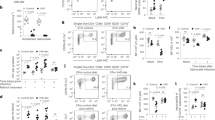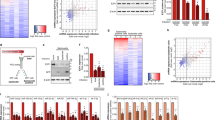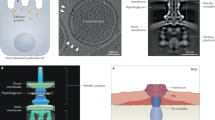Abstract
In humans, Salmonella infection causes two major clinical diseases, typhoid fever and a self-limiting gastro-enteritidis. Salmonella transmission occurs by the fecal–oral route and the interactions between the bacteria and the digestive tract epithelium are central to the outcome of the infection. Using a mouse model of typhoid fever, we previously identified a mutation in USP18 affecting type I interferon (IFN) signaling resulting in increased susceptibility to systemic Salmonella infection. In this study, we demonstrate the effects of this mutation during the early response to Salmonella using a model of typhlitis. Mutant Usp18 mice showed a minimal inflammatory response early after Salmonella Typhimurium infection that was associated with low pathologic scores and low IFN-γ production. This resulted in an increased interaction of Salmonella with the cecal epithelium and earlier systemic dissemination of the bacteria. The global transcriptional signature in the cecum of mouse during Salmonella infection showed normal expression of tissue specific genes and upregulation of type I IFN pathway in mutant mice. In control mice, there was a significant over-representation of genes involved in cellular recruitment and antibacterial activity paralleling the histopathological features. These results show the impact of USP18 in the development of Salmonella-induced typhlitis.
This is a preview of subscription content, access via your institution
Access options
Subscribe to this journal
Receive 6 digital issues and online access to articles
$119.00 per year
only $19.83 per issue
Buy this article
- Purchase on Springer Link
- Instant access to full article PDF
Prices may be subject to local taxes which are calculated during checkout






Similar content being viewed by others
References
Roy MF, Malo D . Genetic regulation of host responses to Salmonella infection in mice. Genes Immun 2002; 3: 381–393.
Skamene E, Gros P, Forget A, Kongshavn PA, St Charles C, Taylor BA . Genetic regulation of resistance to intracellular pathogens. Nature 1982; 297: 506–509.
Vidal SM, Malo D, Marquis JF, Gros P . Forward genetic dissection of immunity to infection in the mouse. Annu Rev Immunol 2008; 26: 81–132.
Maskell D . Salmonella Infections, 1st edn. Cambridge University Press: Cambridge, 2007.
Santos RL, Zhang S, Tsolis RM, Kingsley RA, Adams LG, Baumler AJ . Animal models of Salmonella infections: enteritis versus typhoid fever. Microbes Infect 2001; 3: 1335–1344.
Barthel M, Hapfelmeier S, Quintanilla-Martinez L, Kremer M, Rohde M, Hogardt M et al. Pretreatment of mice with streptomycin provides a Salmonella enterica serovar Typhimurium colitis model that allows analysis of both pathogen and host. Infect Immun 2003; 71: 2839–2858.
Hapfelmeier S, Hardt WD . A mouse model for S. typhimurium-induced enterocolitis. Trends Microbiol 2005; 13: 497–503.
Valdez Y, Grassl GA, Guttman JA, Coburn B, Gros P, Vallance BA et al. Nramp1 drives an accelerated inflammatory response during Salmonella-induced colitis in mice. Cell Microbiol 2009; 11: 351–362.
Stecher B, Paesold G, Barthel M, Kremer M, Jantsch J, Stallmach T et al. Chronic Salmonella enterica serovar Typhimurium-induced colitis and cholangitis in streptomycin-pretreated Nramp1+/+ mice. Infect Immun 2006; 74: 5047–5057.
Vijay-Kumar M, Aitken JD, Kumar A, Neish AS, Uematsu S, Akira S et al. Toll-like receptor 5-deficient mice have dysregulated intestinal gene expression and nonspecific resistance to Salmonella-induced typhoid-like disease. Infect Immun 2008; 76: 1276–1281.
Woo H, Okamoto S, Guiney D, Gunn JS, Fierer J . A model of Salmonella colitis with features of diarrhea in SLC11A1 wild-type mice. PLoS One 2008; 3: e1603.
Schlumberger MC, Kappeli R, Wetter M, Muller AJ, Misselwitz B, Dilling S et al. Two newly identified SipA domains (F1, F2) steer effector protein localization and contribute to Salmonella host cell manipulation. Mol Microbiol 2007; 65: 741–760.
Coburn B, Li Y, Owen D, Vallance BA, Finlay BB . Salmonella enterica serovar Typhimurium pathogenicity island 2 is necessary for complete virulence in a mouse model of infectious enterocolitis. Infect Immun 2005; 73: 3219–3227.
Brown NF, Vallance BA, Coombes BK, Valdez Y, Coburn BA, Finlay BB . Salmonella pathogenicity island 2 is expressed prior to penetrating the intestine. PLoS Pathog 2005; 1: e32.
Hapfelmeier S, Stecher B, Barthel M, Kremer M, Muller AJ, Heikenwalder M et al. The Salmonella pathogenicity island (SPI)-2 and SPI-1 type III secretion systems allow Salmonella serovar typhimurium to trigger colitis via MyD88-dependent and MyD88-independent mechanisms. J Immunol 2005; 174: 1675–1685.
Richer E, Prendergast C, Zhang DE, Qureshi ST, Vidal SM, Malo D . N-ethyl-N-nitrosourea-induced mutation in ubiquitin-specific peptidase 18 causes hyperactivation of IFN-alphabeta signaling and suppresses STAT4-induced IFN-gamma production, resulting in increased susceptibility to Salmonella Typhimurium. J Immunol 2010; 185: 3593–3601.
Miyagi T, Gil MP, Wang X, Louten J, Chu WM, Biron CA . High basal STAT4 balanced by STAT1 induction to control type 1 interferon effects in natural killer cells. J Exp Med 2007; 204: 2383–2396.
Stecher B, Robbiani R, Walker AW, Westendorf AM, Barthel M, Kremer M et al. Salmonella enterica serovar typhimurium exploits inflammation to compete with the intestinal microbiota. PLoS Biol 2007; 5: 2177–2189.
Roy MF, Lariviere L, Wilkinson R, Tam M, Stevenson MM, Malo D . Incremental expression of Tlr4 correlates with mouse resistance to Salmonella infection and fine regulation of relevant immune genes. Genes Immun 2006; 7: 372–383.
Caron J, Lariviere L, Nacache M, Tam M, Stevenson MM, McKerly C et al. Influence of Slc11a1 on the outcome of Salmonella enterica serovar Enteritidis infection in mice is associated with Th polarization. Infect Immun 2006; 74: 2787–2802.
Vidal S, Tremblay ML, Govoni G, Gauthier S, Sebastiani G, Malo D et al. The Ity/Lsh/Bcg locus: natural resistance to infection with intracellular parasites is abrogated by disruption of the Nramp1 gene. J Exp Med 1995; 182: 655–666.
Leverkoehne I, Gruber AD . The murine mCLCA3 (alias gob-5) protein is located in the mucin granule membranes of intestinal, respiratory, and uterine goblet cells. J Histochem Cytochem 2002; 50: 829–838.
Caron J, Loredo-Osti JC, Laroche L, Skamene E, Morgan K, Malo D . Identification of genetic loci controlling bacterial clearance in experimental Salmonella enteritidis infection: an unexpected role of Nramp1 (Slc11a1) in the persistence of infection in mice. Genes Immun 2002; 3: 196–204.
O’Connell RM, Saha SK, Vaidya SA, Bruhn KW, Miranda GA, Zarnegar B et al. Type I interferon production enhances susceptibility to Listeria monocytogenes infection. J Exp Med 2004; 200: 437–445.
Hoebe K, Janssen EM, Kim SO, Alexopoulou L, Flavell RA, Han J et al. Upregulation of costimulatory molecules induced by lipopolysaccharide and double-stranded RNA occurs by Trif-dependent and Trif-independent pathways. Nat Immunol 2003; 4: 1223–1229.
Karaghiosoff M, Steinborn R, Kovarik P, Kriegshauser G, Baccarini M, Donabauer B et al. Central role for type I interferons and Tyk2 in lipopolysaccharide-induced endotoxin shock. Nat Immunol 2003; 4: 471–477.
Harrington L, Srikanth CV, Antony R, Rhee SJ, Mellor AL, Shi HN et al. Deficiency of indoleamine 2,3-dioxygenase enhances commensal-induced antibody responses and protects against Citrobacter rodentium-induced colitis. Infect Immun 2008; 76: 3045–3053.
Ahrens R, Waddell A, Seidu L, Blanchard C, Carey R, Forbes E et al. Intestinal macrophage/epithelial cell-derived CCL11/eotaxin-1 mediates eosinophil recruitment and function in pediatric ulcerative colitis. J Immunol 2008; 181: 7390–7399.
Raupach B, Peuschel SK, Monack DM, Zychlinsky A . Caspase-1-mediated activation of interleukin-1beta (IL-1beta) and IL-18 contributes to innate immune defenses against Salmonella enterica serovar Typhimurium infection. Infect Immun 2006; 74: 4922–4926.
Vazquez-Torres A, Fantuzzi G, Edwards III CK, Dinarello CA, Fang FC . Defective localization of the NADPH phagocyte oxidase to Salmonella-containing phagosomes in tumor necrosis factor p55 receptor-deficient macrophages. Proc Natl Acad Sci USA 2001; 98: 2561–2565.
Hess J, Ladel C, Miko D, Kaufmann SH . Salmonella typhimurium aroA- infection in gene-targeted immunodeficient mice: major role of CD4+ TCR-alpha beta cells and IFN-gamma in bacterial clearance independent of intracellular location. J Immunol 1996; 156: 3321–3326.
Sebastiani G, Blais V, Sancho V, Vogel SN, Stevenson MM, Gros P et al. Host immune response to Salmonella enterica serovar Typhimurium infection in mice derived from wild strains. Infect Immun 2002; 70: 1997–2009.
Ellson CD, Davidson K, Ferguson GJ, O’Connor R, Stephens LR, Hawkins PT . Neutrophils from p40phox−/− mice exhibit severe defects in NADPH oxidase regulation and oxidant-dependent bacterial killing. J Exp Med 2006; 203: 1927–1937.
Flo TH, Smith KD, Sato S, Rodriguez DJ, Holmes MA, Strong RK et al. Lipocalin 2 mediates an innate immune response to bacterial infection by sequestrating iron. Nature 2004; 432: 917–921.
Nairz M, Theurl I, Schroll A, Theurl M, Fritsche G, Lindner E et al. Absence of functional Hfe protects mice from invasive Salmonella enterica serovar Typhimurium infection via induction of lipocalin-2. Blood 2009; 114: 3642–3651.
Jung ID, Lee MG, Chang JH, Lee JS, Jeong YI, Lee CM et al. Blockade of indoleamine 2,3-dioxygenase protects mice against lipopolysaccharide-induced endotoxin shock. J Immunol 2009; 182: 3146–3154.
Borenshtein D, Nambiar PR, Groff EB, Fox JG, Schauer DB . Development of fatal colitis in FVB mice infected with Citrobacter rodentium. Infect Immun 2007; 75: 3271–3281.
Arijs I, Li K, Toedter G, Quintens R, Van Lommel L, Van Steen K et al. Mucosal gene signatures to predict response to infliximab in patients with ulcerative colitis. Gut 2009; 58: 1612–1619.
Boyer E, Bergevin I, Malo D, Gros P, Cellier MF . Acquisition of Mn(II) in addition to Fe(II) is required for full virulence of Salmonella enterica serovar Typhimurium. Infect Immun 2002; 70: 6032–6042.
Acknowledgements
We wish to acknowledge the technical assistance of Nadia Prud’homme and the contribution of the McGill University and Génome Québec Functional Genomics platform personnel and the Innovation Centre. This work was supported by the Canadian Institutes of Health Research (to DM). ER was a recipient of a Fonds de la Recherche en Santé du Québec fellowship. KY is a recipient of a McGill Faculty of Medicine Research Internal Studentship award. DM is a McGill Dawson Scholar.
Author information
Authors and Affiliations
Corresponding author
Ethics declarations
Competing interests
The authors declare no conflict of interest.
Additional information
Supplementary Information accompanies the paper on Genes and Immunity website
Supplementary information
Rights and permissions
About this article
Cite this article
Richer, E., Yuki, K., Dauphinee, S. et al. Impact of Usp18 and IFN signaling in Salmonella-induced typhlitis. Genes Immun 12, 531–543 (2011). https://doi.org/10.1038/gene.2011.38
Received:
Revised:
Accepted:
Published:
Issue Date:
DOI: https://doi.org/10.1038/gene.2011.38



